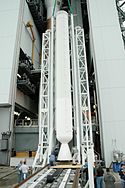AJ-60A
 AJ-60A podnoszony w pozycji pionowej | |
| Kraj pochodzenia | |
|---|---|
| Projektant | Aerojet Rocketdyne |
| Wykorzystanie | Atlas V |
| Materiały napędowe | stałe |
| Pierwszy lot | 12 lipca 2003 |
| Osiągi | |
| Siła ciągu w próżni | 1270 kN[1] |
| Impuls właściwy na poz. morza | 245 s |
| Impuls właściwy w próżni | 275 s |
| Maks. czas działania | 94 s |
| Parametry | |
| Komory spalania | 1 |
| Wymiary | |
| Długość | 17 m |
| Średnica | 1,6 m |
| Masa | 46 697 kg |
AJ-60A[2] – silnik rakietowy na paliwo stałe, opracowywany w latach 1996-2003, produkowany obecnie przez firmę Aerojet Rocketdyne na potrzeby rakiet Atlas V.
Konstrukcja
Silnik ten jest zasilany paliwem stałym o nazwie HTPB - związkiem chemicznym będącym oligomerem 1,3-butadienu. Obudowa oraz dysza wykonane są z kompozytów. Dysza silnika jest zwykle przechylona o 3 stopnie w kierunku przeciwnym do środka masy, mimo to oferowany jest również wariant z ciągiem wektorowanym[3]. Na samym wierzchu silnika montowana jest ścięta (w wersji dla rakiet Atlas V) lub standardowa kopułka.
Następca
W 2015 przedstawiciele firmy United Launch Alliance ogłosili plany porzucenia AJ-60A jako silnika pomocniczego dla rakiet Atlas V i zastąpienia ich konstrukcją o nazwie GEM-63, produkowaną przez przedsiębiorstwo Orbital ATK. Wydłużona wersja tego silnika ma być używana w planowanej rakiecie Vulcan[4].
Przypisy
- ↑ Mark Wade: Aerojet SRB. Encyclopedia Astronautica. [dostęp 2016-10-03].
- ↑ Niekiedy spotyka się oznaczenia Atlas V SRB bądź Aerojet SRB.
- ↑ Atlas V Solid Rocket Motor. Aerojet Rocketdyne. [dostęp 2016-10-03]. [zarchiwizowane z tego adresu (2017-03-14)].
- ↑ Jason Rhian: ULA selects Orbital ATK’s GEM 63/63 XL SRBs for Atlas V and Vulcan boosters. 2015-09-23. [dostęp 2016-10-03].
Media użyte na tej stronie
The flag of Navassa Island is simply the United States flag. It does not have a "local" flag or "unofficial" flag; it is an uninhabited island. The version with a profile view was based on Flags of the World and as a fictional design has no status warranting a place on any Wiki. It was made up by a random person with no connection to the island, it has never flown on the island, and it has never received any sort of recognition or validation by any authority. The person quoted on that page has no authority to bestow a flag, "unofficial" or otherwise, on the island.
KENNEDY SPACE CENTER, FLA. – On Launch Complex 41 at Cape Canaveral Air Force Station in Florida, the fifth and final solid rocket booster is raised to a vertical position. It will be lifted into the Vertical Integration Facility and added to the other four already mated to the Lockheed Martin Atlas V rocket there. The Atlas V is the launch vehicle for the Pluto-bound New Horizons spacecraft that will make the first reconnaissance of Pluto and its moon, Charon - a "double planet" and the last planet in our solar system to be visited by spacecraft. As it approaches Pluto, the spacecraft will look for ultraviolet emission from Pluto's atmosphere and make the best global maps of Pluto and Charon in green, blue, red and a special wavelength that is sensitive to methane frost on the surface. It will also take spectral maps in the near infrared, telling the science team about Pluto's and Charon’s surface compositions and locations and temperatures of these materials. When the spacecraft is closest to Pluto or its moon, it will take close-up pictures in both visible and near-infrared wavelengths. The mission will then visit one or more objects in the Kuiper Belt region beyond Neptune. New Horizons is scheduled to launch in January 2006, swing past Jupiter for a gravity boost and scientific studies in February or March 2007, and reach Pluto and Charon in July 2015.

